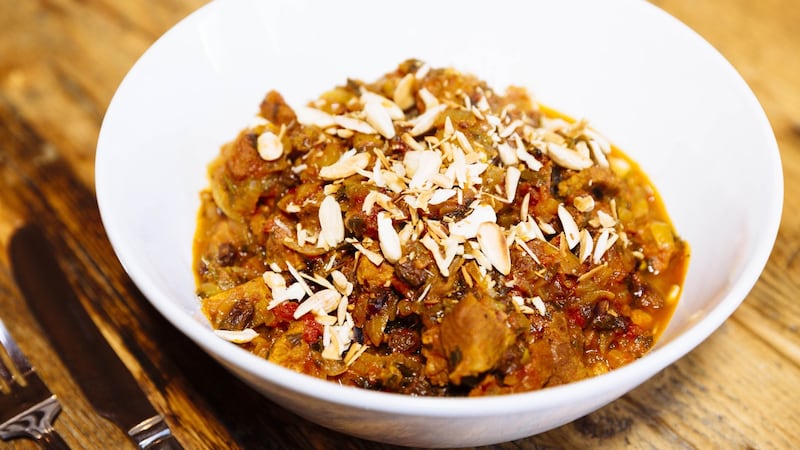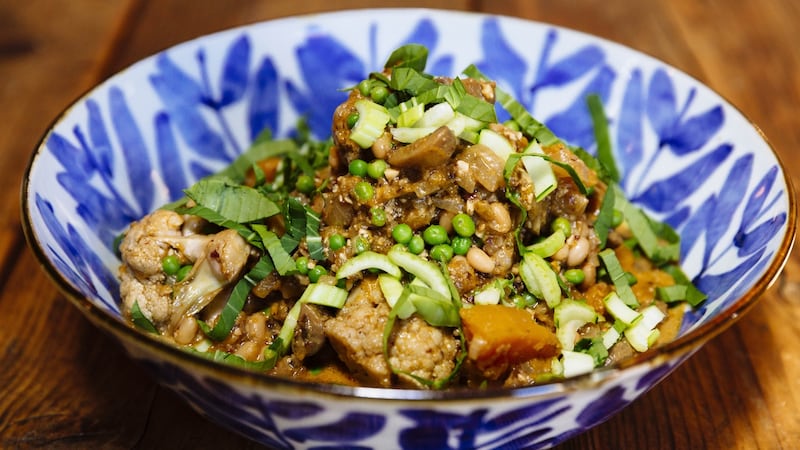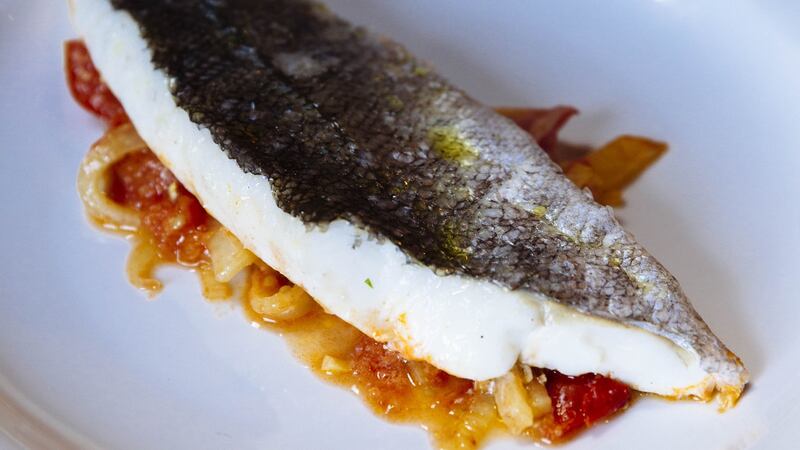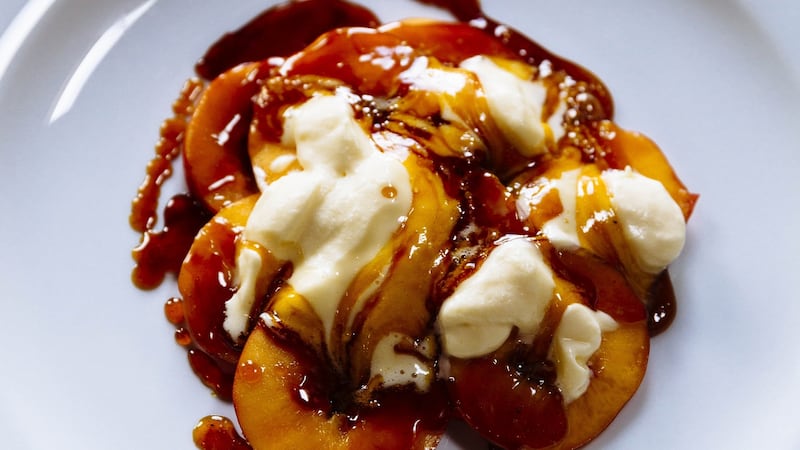Recently, I’ve become aware that I’ve been eating too fast and I’m finding it a challenge to slow down. Eating quickly is a habit that creeps up on us – many of us struggle to even find time to sit down to eat, never mind taking our time when we do so. As a result, we are inclined to gulp and go without even paying attention to what is on our plates.
I grew up in a large family where eating quickly was a sport. It was the only way of getting second helpings and sometimes even first helpings of a favourite dish. I found this scary, competitive and addictive.
Therefore, at boarding school I was ahead of the game when it came to getting the first pouring (with the cream on top) of the unpasteurised milk, the biggest slice of ginger cake at lunch, and an extra egg at supper.
When I moved to France I witnessed a very different way of dining. I couldn’t believe my luck, all this beautiful food and everyone is calm, relaxed and slow – and I was undeniably quick. I’d continue to eat and eat, at a speed that brought a look of horror to the faces of my French friends, until one day I was told if I kept going at this rate I would grow in the wrong places, and I did.
I learnt the art of eating slowly, of table conversations and tasting my food completely and consciously. Over time, I became such a slow eater it became a joke among my friends and family. I was always the last to finish.
I pride myself in guessing what people do for a living by observing their eating habits. At a party a couple of years ago, someone at my table suggested we play “guess what we do for a living”.
Instantly I knew the man to my right was a doctor and the lady opposite me a nurse. They were the first to finish their food and still managed to contribute to the conversation. Nurses, I’ve noticed, often add cold water to their tea for quick consumption.
Recently, I read an article by a doctor on the health risks of eating too quickly. While blaming his junior doctor years for his habit of eating like a labrador, he points out that slow eating reduces weight gain, either because those “I’m full” signals kick in before we have wolfed down 5,000 calories, or simply because if you only have a set time for a meal, slow eating means you eat less, taste more and make time for meaningful conversations that distract you from your stomach.
So be kinder to your bodies, nervous systems and allow your taste buds to develop. Today’s recipes are all adaptable to a slow cooker, so you can also enjoy some slow nibbles as your meal takes care of itself. Here is a chance to pull that gadget from the back of the press, dust it down and have a few slow days. When adapting recipes for a slow cooker, if adding liquid, reduce it by half.
LAMB WITH ALMONDS AND RAISINS
Serves six
If you're short on time, this dish will still work if you skip baking it in the oven. Use either a heavy-based saucepan that goes from hob to oven to table or your slow cooker.

Ingredients
1kg stewing lamb
Olive oil
2 medium onions, finely chopped
4 cloves garlic, finely chopped
Salt and pepper
2tsp turmeric
½tsp powdered ginger
½tsp cayenne pepper
1 tin of tomatoes
300ml water
Some chopped parsley and coriander
200g raisins, soaked in water while you cook the meat
100g slivered almonds
Method
1 In the saucepan, place the meat, onions, garlic, salt, pepper and the spices along with four tablespoons of oil. Mix very well and add the tomatoes and water. Bring to the boil, reduce the heat, cover and let simmer for about 45 minutes.
2 Add the drained raisins and herbs. Cook for another 30 minutes (without the lid) or until the meat is tender and the sauce looks like a thick gravy. If you are cooking this a day in advance, let it cool now and keep in the fridge and reheat the next day.
3 Preheat the oven to 180 Celsius/gas 4.
4 Transfer the saucepan (without the lid) with the meat and bake in the oven for about 15 minutes until the meat is glazed.
5 Heat a dry frying pan and toast the almonds over a medium flame and sprinkle over the top of the lamb just before serving. Serve with rice.
SQUASH AND CAULIFLOWER STEW WITH CHILLI, SPICES AND GROUND NUTS
Serves six
This stew is a complete meal in one pot. Feel free to use a mixture of root vegetables or what is lying around in your fridge. With a little effort this dish can be upgraded to dinner-party status by serving it with fried polenta squares and a bowl of cucumber salsa dressed with lime juice.

Ingredients
3tsp cumin seeds
2tsp fennel seeds
4tsp dried oregano
4tbsp sesame seeds
50g whole almonds
50g cashew nuts
1tsp chilli powder
Olive oil
2 onions, roughly chopped
2 cloves garlic, chopped
Small piece of fresh ginger
Salt and pepper
1 butternut squash, thickly sliced
500ml vegetable stock
1 head of cauliflower, broken into florets
1 tin of coconut milk
250g frozen peas
250g mushrooms, sliced or whole
Pak choi, shredded
Chopped coriander and mint
Method
1 Toast the cumin and fennel seeds in a dry pan until they start to brown and the aroma is filling the air. Mix the spices with the oregano and grind.
2 In the same pan, toast the sesame seeds until lightly browned, followed by the almonds and cashews. Roughly chop the nuts and mix with the sesame seeds. Roughly process the mixture, remove half (to sprinkle over before serving) while still rough and continue to process the rest to a fine powder. Now purée the onions, garlic, chilli and ginger.
3 Add some oil to a large casserole pan and cook the purée for a few minutes, seasoning well with salt and pepper. Add the ground spice mixture and cook for another minute.
4 Next add the squash and the stock and cook for 15 minutes or until the squash is nearly soft.
5 Add the cauliflower and the powdered nut and seed mixture along with the tin of coconut milk. Bring back to the boil and simmer until the cauliflower is nearly tender. Add the peas and mix in well and allow to simmer for another couple of minutes.
6 In the meantime, heat a frying pan until hot, add some oil followed by the mushrooms and season well with salt and pepper. Continue with the heat high until the mushrooms are nicely brown and no liquid remains.
7 To serve, scatter the mushrooms over the stew followed by the chopped nuts, the shredded pak choi and the chopped herbs.
FISH POACHED IN FENNEL Á LA GREQUE
Serves six
This sauce is a classical dish and is typically served at room temperature as part of a mezze or a buffet table. Here, I am using it to create a one-pot meal that is hassle free, simple and fresh. It also works well with chicken, lamb or simply tossed into some pasta for a quick supper.

Ingredients
3 x 350g fish fillets
2 medium onions
2 large cloves garlic, crushed
150ml olive oil
500g tomatoes, chopped
1tsp coriander seeds, ground
1tsp fennel seeds, ground
100ml dry white wine
Juice of 2 lemons
Salt and pepper
3 heads fennel, sliced
Method
1 First make the sauce. Heat a pan and add the oil followed by the onions and garlic. Allow them to stew gently until they are soft. Add the tomatoes and the spices, then the wine, lemon and seasoning and simmer for 10 minutes. Add the fennel and mix it in well to the sauce, cover the pan with a lid and allow to stew for about 30 minutes. Check the sauce after 20 minutes and add a drop of water if needed.
2 Either heat the oven to 200ºC or cook the fish in the pot with a lid on. Place the fish on top of the sauce and bake in the oven for 10 to 12 minutes depending on the thickness of the fillets. Otherwise, place a lid on the top, turn the heat to medium and allow the fish to steam on top of the sauce for 8 to 10 minutes.
NECTARINES WITH CREAM AND CARAMEL
Serves six
You have probably noticed by now that I am not big on desserts but how can anyone say no to peaches and cream, or nectarines and cream in this case. With the addition of caramel, it is just the perfect end to any meal. I find nectarines travel and ripen better than peaches, making them the perfect fruit for lazy cooking. Making caramel is one of the most mindful tasks in the kitchen. There is something mesmerising about watching sugar turn golden to dark brown, turning a simple ingredient into a real luxury.

Ingredients
6 ripe nectarines
400ml double cream
350g sugar
Method
1 Whip the cream to soft peaks and divide between six plates.
2 Slice the nectarines and place on top of the cream as you go.
3 Finally, make the caramel by placing the sugar in a saucepan along with just enough water to soak the sugar. Place over a low heat until the sugar has dissolved. Turn up the heat and boil until it begins to turn golden brown. Now, keep an eye and as soon as it starts to darken, swirl it over the cream and fruit. Watch it bubble and set.



















